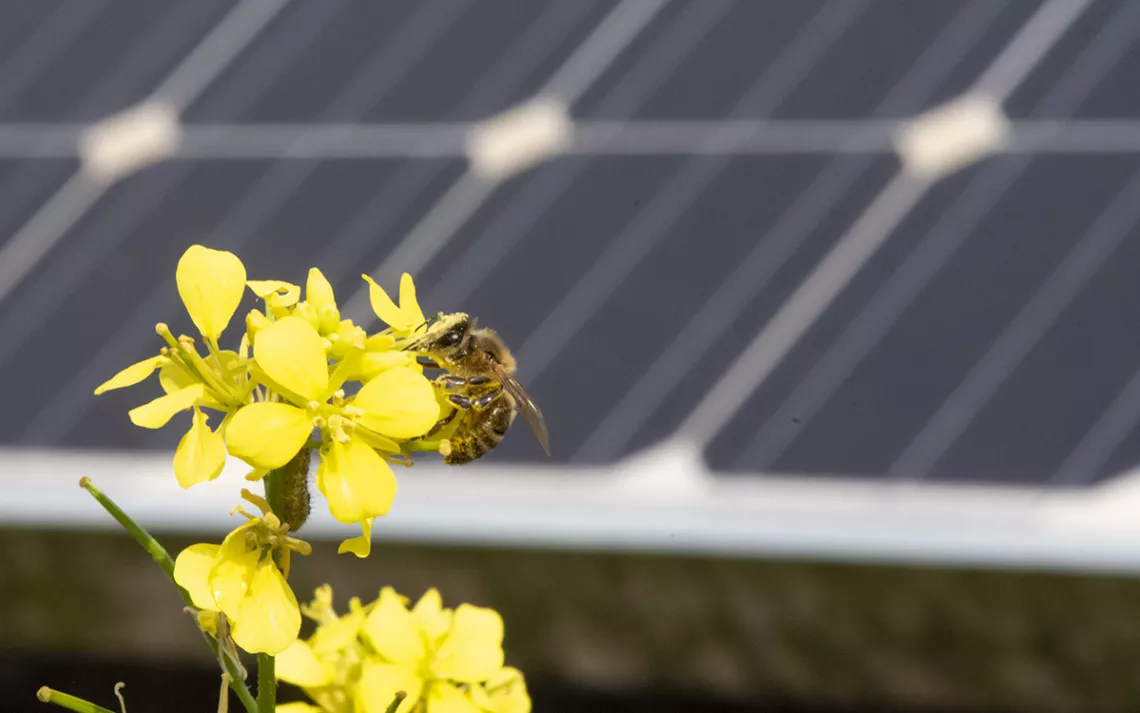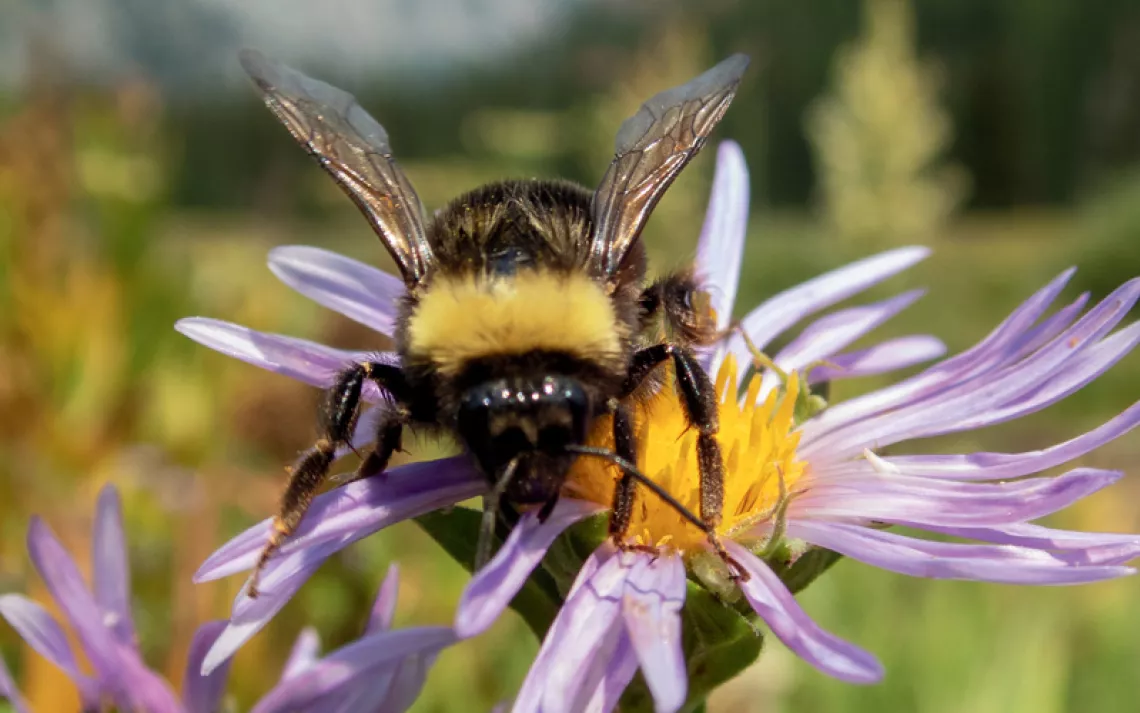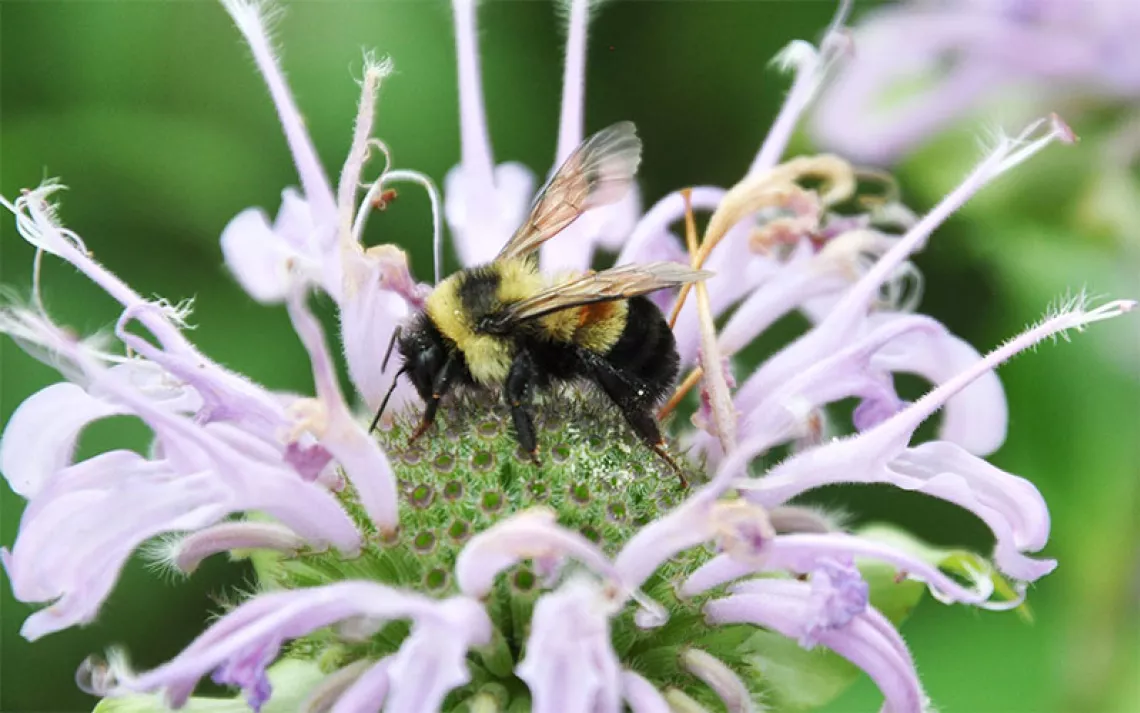Can Big Solar Installations Help Foster Biodiversity?
Some solar farms are providing habitat for bees, birds, and butterflies

Photo courtesy of Lightsource bp
At the end of last year, workers in Sacramento County, California, completed construction of a 16.5-megawatt solar park on what was once open ranchland. In December, the Rio Linda solar farm began producing enough energy to power 2,600 homes annually. Usually, the ground underneath big solar installations is scraped and covered with gravel or low grass, but if you drive by this solar farm, you’ll be treated to a different view: an array of pollinator-friendly native plants and wildflowers like purple needlegrass and California poppy. Underneath the utility lines, 1.5 acres have been planted with shrubs like milkweed, which will attract monarch butterflies. Coyote mint and evening primrose will bloom in the summer and fall.
Pollinator species like bees, hummingbirds, and monarch butterflies are in serious decline around the globe. According to the Center for Biological Diversity, for example, more than 40 percent of insect pollinators are highly threatened. This is a serious problem for plants that require pollination—and the humans who rely on them for food, medicine, and other consumer goods. Kathleen Ave, the senior climate program manager at the Sacramento Municipal Utility District, sees solar projects that double as pollinator habitat like the one in Rio Linda as critical. “People in utilities don’t generally think about biodiversity as their job, even though we do have influence over a lot of land,” she says. “[Combining biodiversity and renewable energy] is going to be an uphill battle to make it a norm, but it’s such a good goal.”

Sign up to receive Sierra News & Views
Get articles like this one sent directly to your inbox weekly.
With this action you affirm you want to receive Sierra Club communications and may vote on policy designated by the Sierra Club Board.
This goal takes on even greater importance in light of the Biden administration’s ambitious plans to achieve net-zero carbon emissions by 2050. Currently, solar energy in the US provides as much as 85 gigawatts of power—a small but growing portion of the total energy the country uses annually (1,000 gigawatts). Meeting the Biden administration’s climate targets will require a significant increase in the production of solar energy, but that demands massive amounts of land. Large-scale solar projects use about six to seven acres for every megawatt of energy, according to the Solar Energy Industries Association. Scraping, leveling, and filling that land with gravel or turf presents a huge conservation issue, according to Ave. “We’re going to look back and think, 'What an ecological disaster,'” she says.
While the idea of combining solar farms and native vegetation is just taking hold in the US, it’s been common in Europe for years. One of the largest solar parks in the world, Lieberose, was built on a former military training ground in Germany. Several tons of munition such as land mines and grenades were removed and replaced with plant life and solar panels, which began producing energy in 2010. According to one study, some bird species doubled within three years.
Turning solar installations into pollinator habitat provides other benefits as well. According to an article by the Maine Organic Farmers and Gardeners organization, planting native seed mixes of shade-tolerant plants underneath the solar panels can cost less than filling the land with gravel. In addition, it requires less maintenance than low grass since it does not require regular pesticide distribution. The soil beneath the solar panels will be rich in organic matter and pesticide-free, and could eventually be used to grow crops like broccoli and cabbage, which can handle shade. As an added bonus, the soil will capture and store atmospheric carbon dioxide, which contributes to the ultimate goal of reducing global climate change.
Lee Walston and his colleagues at Argonne National Laboratory examined the potential financial benefit of planting pollinator habitats beneath solar panels on solar farms across the United States. In a 2018 study published in Environmental Science and Technology, the researchers mapped out areas where solar energy facilities and pollinator-dependent cropland overlap. They estimated that if solar energy and pollinator conservation were combined in these locations, 3,500 km2 of agricultural land would fall within foraging distance of solar projects, or more than 650,000 football fields. Building pollinator habitats near farmland would increase visits from pollinators like bees and butterflies, which, the researchers hypothesized, would convert to increased crop production. Even if nearby pollinator habitats increased crop yield by a mere 1 percent in these areas—a conservative estimate, according to Walston—production could increase by millions of dollars in pollinator-dependent crops, such as soybeans and almonds.
The idea is slowly catching on. Six states in the Midwest and on the East Coast have adopted legislation that allows solar sites to be designated as pollinator-friendly. “As more states adopt voluntary pollinator-friendly solar guidelines, we can expect solar plus pollinator to be the norm for most future solar facilities going forward,” Walston says.
In California, which produced 22 percent of its electricity and powered nearly 8 million homes using solar in 2019, the not-for-profit renewable electricity provider MCE announced last year that pollinator habitats are required for all of its new solar projects. Lightsource bp, the company behind the Rio Linda project, also has plans to incorporate vegetation into future solar farms.
Overall, thinking about the big picture is key when it comes to the environment, Ave suggests, and this means working on multiple problems at once. “Humans—we’ve got to stop doing just one thing at a time. It’s not enough to do just renewable electricity. That’s great, and it’s better than fossil fuels, but we have to start focusing on repairing the damage we’ve done."
 The Magazine of The Sierra Club
The Magazine of The Sierra Club



